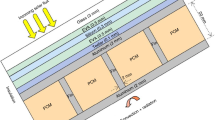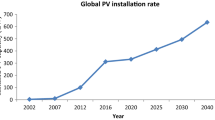Abstract
This study designed and optimized the system parameters for a photovoltaic thermal system (PV/thermal system) combined with reflectors. Moreover, it discussed the gain of electrical efficiency and thermal efficiency on the system after adding two reflectors on each of the south and north sides, and adjusting the water circulation system. As the rising angle and position of the sun varies each season, in order to make this study more rigorous, experiments were conducted in four seasons of a year. The Taguchi orthogonal array was used for experimental planning, and the optimal parameters were analyzed for electrical efficiency and thermal efficiency. The analysis of variance was conducted to examine the influential parameters, and principal component analysis was used to calculate the principal component point of each experiment. The results were employed to construct a response surface methodology model. Finally, the steepest descent method was applied to obtain the optimal parameters. The reflector theory was applied to calculate the gain of solar radiation amount after installing the reflector. Moreover, the gain was inputted into the simulation software TRNSYS to simulate the electrical power output and the water temperature in the water storage tank. The confirmatory experiments of the four seasons found that the electrical energy after installing the reflector increased by 0.117–0.183 kWh, and the thermal energy increased by 1.7–2.6 \(^{\circ }\hbox {C}\). The experiment confirmed that the prediction error was \(<\)4 %.







Similar content being viewed by others
Abbreviations
- P:
-
Total generated electrical energy during the day (kWh)
- G:
-
Total solar radiation energy during the day \((\hbox {J/m}^{2})\)
- A:
-
Module dimension \((\hbox {m}^{2})\)
- \(\hbox {V}_{\mathrm{m}}\) :
-
PV voltage at maximum power point (V)
- \(\hbox {I}_{\mathrm{m}}\) :
-
PV current at maximum power point (A)
- Q:
-
Total generated thermal energy during the day (J)
- V:
-
Water mass flow rate (kg/s)
- \(\hbox {C}_{\mathrm{p}}\) :
-
Water specific heat (4.18 kJ/kg \(^\circ \hbox {C}\))
- \(\hbox {T}_{\mathrm{f}}\) :
-
Water final temperature \(({^\circ }\hbox {C})\)
- \(\hbox {T}_{\mathrm{i}}\) :
-
Water initial temperature \(({^\circ }\hbox {C})\)
- \(\hbox {A}_{\mathrm{r1\_a}}\) :
-
Actual receivable area of upper reflector \((\hbox {m}^{2})\)
- \(\hbox {W}_{1}\) :
-
Upper plate width (m)
- \(\hbox {W}_{1^{\prime }}\) :
-
Upper plate reflect to module width (m)
- \(\hbox {L}_{1^{\prime }}\) :
-
Upper plate reflect to module height (m)
- \(\hbox {L}_{1}\) :
-
Upper plate height (m)
- \(\hbox {A}_{\mathrm{r1}}\) :
-
Reflection area of upper reflector \((\hbox {m}^{2})\)
- \(\uptheta \) :
-
Included angle between reflector and azimuth \(({^\circ }\hbox {C})\)
- \(\hbox {A}_{\mathrm{r2\_a}}\) :
-
Actual receivable area of lower reflector \((\hbox {m}^{2})\)
- \(\hbox {W}_{2}\) :
-
Lower plate width (m)
- \(\hbox {W}_{2^{\prime }}\) :
-
Lower plate reflect to module width (m)
- \(\hbox {L}_{2}\) :
-
Lower plate height (m)
- \(\hbox {L}_{2^{\prime }}\) :
-
Lower plate reflect to module height (m)
- \(A_{r2}\) :
-
Reflection area of lower reflector \((\hbox {m}^{2})\)
- \(\hbox {G}_{\mathrm{r1\_c}}\) :
-
Reflection solar radiation of upper plate \((\hbox {J/m}^{2})\)
- \(\hbox {G}_{\mathrm{r1}}\) :
-
Receiving solar radiation of upper reflector \((\hbox {J/m}^{2})\)
- \(\hbox {L}_{1}^{{\prime }{\prime }}\) :
-
Upper plate reflect to module lengthen width (m)
- \(\hbox {G}_{\mathrm{r2\_c}}\) :
-
Reflection solar radiation of lower plate \((\hbox {J/m}^{2})\)
- \(\hbox {G}_{\mathrm{r2}}\) :
-
Receiving solar radiation of lower reflector \((\hbox {J/m}^{2})\)
- \(\hbox {L}_{2}^{{\prime }{\prime }}\) :
-
Lower plate reflect to module lengthen width (m)
- C:
-
Concentration ratio (–)
- S/N:
-
Signal to noise ratios
- n:
-
Experimental numbers
- y:
-
Experimental results
- Y:
-
Principal components
- \(\hbox {Y}_{\mathrm{k}}\) :
-
Matrix of k row vectors
- \(\hbox {C}_{\mathrm{k}}\) :
-
covariance matrix
- x:
-
Factor level
- \(\uprho \) :
-
Reflection coefficient of reflector (–)
- \(\upalpha \) :
-
Elevation angle of sun \(({^\circ })\)
- \(\upbeta \) :
-
Collector inclination \(({^\circ })\)
- \(\upalpha _{1}\) :
-
Inclination of upper reflector \(({^\circ })\)
- \(\uptau \) :
-
Included angle between upper reflected light and collector \(({^\circ })\)
- \(\upalpha _{2}\) :
-
Inclination of lower reflector \(({^\circ })\)
- \(\upchi \) :
-
Included angle between lower reflected light and collector \(({^\circ })\)
- \(\upbeta _{0}\) :
-
Regression coefficient
References
Bollentin, J. W., & Wilk, R. D. (1995). Modeling the solar irradiation on flat plate collectors augmented with planar reflectors. Solar Energy, 55, 343–354.
Calise, F., d’Accadia, M. D., Palombo, A., & Vanoli, L. (2013). Dynamic simulation of a novel high-temperature solar trigeneration system based on concentrating photovoltaic/thermal collectors. Energy, 61, 72–86.
Chang, C. (2012). Collaborative decision making algorithm for selection of optimal wire saw in photovoltaic wafer manufacture. Journal of Intelligent Manufacturing, 23, 533–539.
Çiçek, A., Kivak, T., & Ekici, E. (2013). Optimization of drilling parameters using Taguchi technique and response surface methodology (RSM) in drilling of AISI 304 steel with cryogenically treated HSS drills. Journal of Intelligent Manufacturing,. doi:10.1007/s10845-013-0783-5.
He, W., Zhang, Y., & Ji, J. (2011). Comparative experiment study on photovoltaic and thermal solar system under natural circulation of water. Applied Thermal Engineering, 31, 3369–3376.
Huang, B. J., Lin, T. H., Hung, W. C., & Sun, F. S. (2001). Performance evaluation of solar photovoltaic/thermal systems. Solar Energy, 70, 443–448.
Ibrahim, A., Othman, M, Y., Ruslan, M, H., Mat, S., & Sopinan, K. (2011). Recent advances in flat plate photovoltaic/thermal (PV/T) solar collectors. Renewable and Sustainable Energy Reviews, 15, 352–365.
Kostic, L. T., Pavlovic, T. M., & Pavlovic, Z. T. (2010). Optimal design of orientation of PV/T collector with reflectors. Applied Energy, 87, 3023–3029.
Kreith, F., & Kreider, J. F. (1978). Principles of solar engineering. Colorado: Hemisphere.
Kumar, R., Kaushink, S. C., & Garg, H. P. (1995). Analytical study of collector solar-gain enhancement by multiple reflectors. Energy, 20, 511–522.
Kuo, C. F. J., Su, T. L., Jhang, P. R., Huang, C. Y., & Chiu, C. H. (2011). Using the Taguchi method and grey relational analysis to optimize the flat-plate collector process with multiple quality characteristics in solar energy collector manufacturing. Energy, 36, 3554–3562.
Kuo, C. F. J., Dewantoro, G., & Huang, C. C. (2013). Optimization of injection-molded light guide plate with microstructures by using reciprocal comparisons. Journal of Intelligent Manufacturing,. doi:10.1007/s10845-013-0826-y.
Kuo, C. F. J., Lan, W. L., Chang, Y. C., & Lin, K. W. (2014). The preparation of organic light-emitting diode encapsulation barrier layer by low-temperature plasma-enhanced chemical vapor deposition–a study on the SiOxNy film parameter optimization. Journal of Intelligent Manufacturing, 3, 1–2. doi:10.1007/s10845-014-0893-8.
Lin, H. T., & Huang, K. T. (2005). The Research and application of typical meteorological years of Taiwan. Journal of Architecture, 53, 79–94.
Muhammad, N., Manurung, Y., Jaafar, R., Abas, S., Tham, G., & Haruman, E. (2013). Model development for quality features of resistance spot welding using multi-objective Taguchi method and response surface methodology. Journal of Intelligent Manufacturing, 24, 1175–1183.
Pandey, R. K., Panda, S. S., Zain, A. M., Radzi, N. M., & Othman, M. R. (2013). Optimization of bone drilling using Taguchi methodology coupled with fuzzy based desirability function approach. Journal of Intelligent Manufacturing, 25, 99–107. doi:10.1007/s10845-013-0844-9.
Robles-Ocampo, B., Ruiz-Vasquezb, E., Canseco-Sanchez, H., Cornejo-Mezac, R. C., Trapaga-Martinezd, G., Garcia-Rodrigueza, F. J., et al. (2007). Photovoltaic/thermal solar hybrid system with bifacial PV module and transparent plane collector. Solar Energy Materials and Solar Cells, 91, 1966–1971.
Sibalija, T., & Majstorovic, V. (2012). An integrated approach to optimize parameter design of multi-response processes based on Taguchi method and artificial intelligence. Journal of Intelligent Manufacturing, 23, 1511–1528.
Souliotis, M., Quinlan, P., Smyth, M., Tripanagnostopoulos, Y., Zacharopoulos, A., Ramirez, M., et al. (2011). Heat retaining integrated collector storage solar water heater with asymmetric CPC reflector. Solar Energy, 85, 2474–2487.
Tiwari, A., & Sodha, M. S. (2006). Performance evaluation of solar PV/T system: An experimental validation. Solar Energy, 80, 751–759.
Tripanagnostopoulos, Y., Nousia, T. H., Souliotis, M., & Yianoulis, P. (2002). Hybrid photovoltaic/thermal solar systems. Solar Energy, 72, 217–234.
Tyagi, V. V., Kaushik, S. C., & Tyagi, S. K. (2012). Advancement in solar photovoltaic/thermal (PV/T) hybrid collector technology. Solar Energy, 16, 1383–1398.
Vadde, K. K., Syrotiuk, V. R., & Montgomery, D. C. (2006). Optimizing protocol interaction using response surface methodology. IEEE Transactions on Mobile Computing, 5, 627–639.
Yang, Y., Shih, C., & Fung, R. (2014). Multi-objective optimization of the light guide rod by using the combined Taguchi method and grey relational approach. Journal of Intelligent Manufacturing, 25, 99–107.
Zainal, N., Zain, A. M., Radzi, N. M., & Othman, M. R. (2013). Glowworm swarm optimization of machining parameters combined Taguchi method and grey relational approach. Journal of Intelligent Manufacturing, 25, 99–107. doi:10.1007/s10845-014-0914-7.
Zondag, H. A., de Vries, D. W., van Helden, W. G. J., van Zolingen, R. J. C., & van Steenhoven, A. A. (2002). The thermal and electrical yield of a PV–thermal collector. Solar Energy, 72, 113–128.
Acknowledgments
The research was supported by the Bureau of Energy, Ministry of Economic Affairs, Republic of China, under the Grant No. 102-E0608.
Author information
Authors and Affiliations
Corresponding author
Rights and permissions
About this article
Cite this article
Kuo, CF.J., Syu, SS., Shih, CY. et al. Optimization and practical verification of system configuration parameter design for a photovoltaic thermal system combined with a reflector. J Intell Manuf 28, 1017–1029 (2017). https://doi.org/10.1007/s10845-015-1043-7
Received:
Accepted:
Published:
Issue Date:
DOI: https://doi.org/10.1007/s10845-015-1043-7




